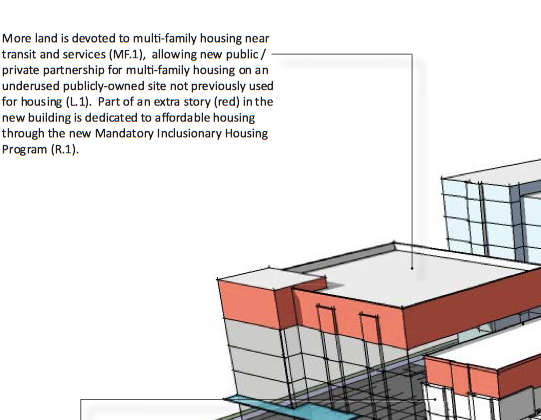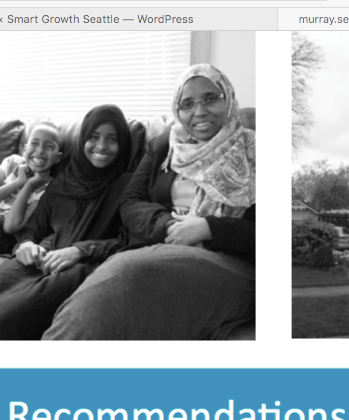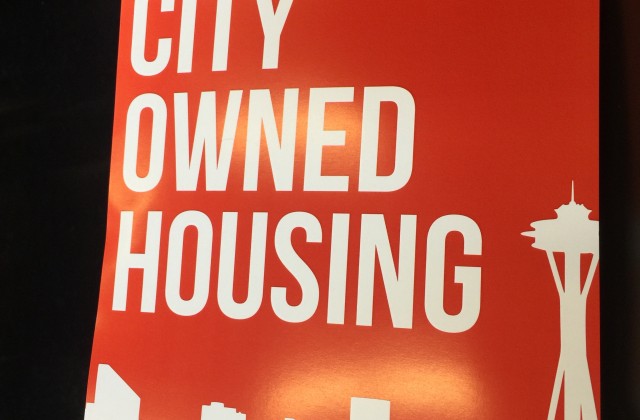HALA’s Most Confusing Recommendation: The Pushes and Pulls of MIZ
This is the second installment of three blogs posts I’m writing about individual recommendations within HALA. I have researched each one and it is no surprise that the award for most confusing HALA recommendation goes to “R1 Partnership for Mandatory Inclusionary Housing – Development Driven Affordability Strategy” or, in local government parlance, Mandatory Inclusionary Zoning (MIZ). The variation between, and flexibility within, each MIZ program make them popular in developing regions such as Seattle; of course this is exactly why they are so complicated. There are nearly an infinite number of ways that the housing market, program design, and local economy interact that should be, but cannot be, considered when developing an MIZ program for an area.
For encouraging economic and social integration, MIZ compares favorably with others programs with similar goals e.g., housing vouchers, or Low-Income Housing Tax Credit (LIHTC). According to a study of 11 jurisdictions carried out by the RAND Corporation, MIZ programs built affordable units in areas where people below the poverty line constitute <10% of the population, compared to a 34 % low-income population where LIHTC units are, and 28 % low-income population where housing-vouchers are used.[1]
Long term affordability of housing is something that renders MIZ programs attractive, most MIZ programs require affordable units to remain that way for decades in order to allow low-income families to reap the benefits typically associated with a higher socio-economic environment. Integrative, long-term affordability, proportional affordability mandates, and developer incentives should make MIZ successful. But, where MIZ operates, how many units are being built compared with how many are needed? And how might MIZ impact the market momentum of a housing development? What does MIZ mean for pricing and sizing of the market-rate housing in the area? MIZ is advertised as a “grand bargain” because it requires minimal government subsidy, but what are some of the others costs to this program we should pay attention to?
Developers are the first to encounter MIZ. When developers assess a project proposal they use marginal analysis of costs and benefits to decide which projects to pursue. Because MIZ is likely to reduce the profit margin that they can anticipate from any given project, in a free market, it is likely that they will focus their attention on developments in areas where MIZ is not in force and, frankly, they can make more profit.[2] To a developer MIZ will look like a form of selective taxation imposed on operating in particular areas.
Where developers have built in a MIZ area, the tax has usually been passed on to the renters and homeowners. Where MIZ was imposed in California, housing prices increased 2-3% faster than where they did not adopt the policy.3 Homes in these areas were also smaller.[3]
There are other unanticipated effects of MIZ: If population is increasing (as it is in Seattle) and new construction is hampered due to increased government regulation, it is probable that new residents will begin to bid against existing residents and drive up the price of even low-quality homes. How will these market-impacts of MIZ address the affordability crisis here? A recent article from the New York Times alludes to how costly the subsidies of MIZ can be;
“…the affordable housing units created by inclusionary zoning are extremely expensive. The subsidy to each family getting an affordable two-bedroom unit at Abington House will be worth nearly $90,000 a year. That money could cover rent for several families in a middle-income neighborhood in boroughs outside Manhattan, like Sunnyside, Queens.”[4]
The grand appeal of MIZ stems from an “egalitarian ideology” but it’s hard to argue against the numbers in this report and various others. [5] It is confusing that the community is focused on this one recommendation, which is sure to come short of addressing the housing crisis, when there are many other effective strategies that, with support, will effectively build affordable homes across the City of Seattle.
[1] Heather L. Schwartz, Liisa Ecola, Kristin J. Leuschner, and Aaron Kofner. 2012. Is Inclusionary Zoning Inclusionary? Santa Monica, CA: RAND Corporation, 13–21.
[2] Powell, R., Doherty, G., “Demographic and Economic Constraints on the Inclusionary Zoning Strategy Utilized for the Production of Low and Moderate Income Housing in New Jersey.” Nassau Capital Advisors, LLC. 2015
[3] Knapp, G., Bento, A., & Lowe, S. (2008). Housing Market Impacts of Inclusionary Zoning.
College Park, MD: National Center for Smart Growth Research and Education.
[4] http://www.nytimes.com/2014/06/08/upshot/affordable-housing-thats-very-costly.html?_r=0
[5] Powell, B. and Stringham, E. “The Economics of Inclusionary Zoning Reclaimed: How Effective Are Price Controls?” Florida State Law Review. 2005. 471 – 499
HALA Detail: Will Council Fully Support HALA’s Cottage Recommendations?
As an intern with Smart Growth Seattle over the past couple of months I have been charged with several duties. One of which was digging into each of HALA’s 65 (really 74) recommendations. The process involved uncovering who is responsible, who benefits, and what, if anything, has been done with the report’s many contentious recommendations and some encouraging but overlooked recommendations. I also compiled a snapshot of the document’s Highest Impact Recommendation. This is the first of three blog posts reflecting on HALA recommendations I found to be the most interesting, the confusing, and finally the most promising.
By reducing the incentive for making a profit, a City ordinance that requires a certain percentage of new housing to be affordable (MIZ) could actually slow the development of new housing. On the other hand, drastic upzoning recommendations have brought strong disapproval and pushback from neighborhood coalitions claiming the character of their neighborhood is threatened. So how about advocating for a middle ground that preserves neighborhood character? How about relaxing existing ordinances on two-thirds of the City’s land to help address the housing crisis?
Recommendation SF1 Increase Supply of Accessory Dwelling Units (ADUs) and Backyard Cottages is deservedly gaining attention here in Seattle. Built either behind homes, attached to homes, or above garages, these units increase density without jeopardizing the true character of their neighborhood. Moreover, because ADUs and Detached Accessory Dwelling Units (DADUs) could be built as infill across the City’s 120,000 single-family lots. It’s suggested that as many as 83,000 lots (~70%) are eligible for this.
However, as explained by the Seattle Times report last year, there are obvious affordability issues in building these units. Developers of these kinds of unit were being slapped with a $10,000 sewage fee, and development estimates range from $55,000 – $200,000. Here are the code barriers HALA recommends removing:
- Remove the parking requirement. Currently, an off-street parking space must be created for an additional ADU or DADU. •
- Remove the ownership requirement. Allow both the accessory and principal unit to be rented [independently]. Currently, the owner must live in one of the two. The ownership requirement is a barrier to securing financing to build an ADU/DADU. Explore the opportunities and implications of Unit Lot Subdivision which would allow separate ownership of the primary dwelling and the accessory dwelling.
- Allow a single lot to have both an ADU and a DADU. Currently only one is allowed.
- Make minor modifications to existing development standards that remove barriers for DADUs, such as height limits, setbacks, maximum square footage, and minimum lot size to ensure constructability.
It’s difficult to say yet whether these easements are enough to spur ADU and DADU development. By the HALA’s forecast a 5% participation rate would serve 4,000 new moderate income peoples over the next 10 years and add welcomed community diversity in areas zoned for Single Family. Young hip couples who don’t want to live in an apartment complex, elder parents who want to live close to their children (granny flats), or single adults are all perfect candidates for ADUs and DADUs.
And, interestingly, Councilmember O’Brien is not proposing removal of the ownership requirement but a year long requirement. Having this barrier at all is likely to create the same issues that have limited households from building a DADU which is perfectly legal today. Removing this requirement makes sense. It’s unclear why O’Brien isn’t following through with the full recommendation which the Council has been hearing for well over a year.
By developing a catalogue of pre-approved plans for backyard cottages, Seattle could remove the “legal stumbling blocks” that San Francisco encountered when pursuing a similar policy and it would expedite, and thereby reduce the cost of, the permit and development processes. Guaranteed charges for utilities and services during the development period would also facilitate this kind of development. If the City adopts SF1 it could substantially increase the size of the housing pool and, ultimately, tax base while distributing the concomitant increase in population over a wide area.
“Beauty Has a Price:” Design as a Weapon Against Growth
Drew Atkins has a great article over at Crosscut headlined, “NIMBYs are wrong on housing, says math.” The opening paragraph is perfect for memorial day:
When it comes to the merits of desecrating graveyards, you’d likely find champions among some housing density zealots. “Sure, it’s disrespectful to build micro-apartments on top of the dead,” they might say. “But are these cadavers using that space effectively? If we’re going to keep this city affordable, we need to prioritize the living, think outside the box.”
Later in the article I am quoted as agreeing with the idea of building on cemeteries.
Also helping to rile opposition are hardcore density advocates like Smart Growth Seattle director Roger Valdez, who provide easy villains (he might actually agree with the graveyard example). During one conversation with him, I tried in vain to find any restraint he’d support on real estate developers, anything that might cut into their profits: more on-site affordable housing, just a little parking, minimum space between buildings, anything. He wouldn’t bite. When I suggested that the city should restrain the construction of buildings so ugly or bland that they’re an insult to one’s sense of sight, he replied simply, “Beauty has a price.” He disagreed, in other words, that buildings should generally attempt to look good.
I love architecture. I love architects. In fact my entire intellectual foundation was poured with lots and lots of Kevin Lynch in the mix; Lynch pioneered planning, but argued that design was an essential part of how the built environment embraces people — or doesn’t. Does an ugly building have a negative impact on my sense of well being? Of course. But, as I pointed out in a very long post about Lynch years ago, cities are about people, not design:
Lynch’s work in mapping the way cities feel and trying to get at how we might willfully do what we know somehow works captures my intuitions about land use and planning. It’s why I suggested earlier this month that design and planning might not matter as much as how we feel about a place. We can try to outsmart ourselves but I don’t think it always works. Put more people together and place happens, not the opposite way around.
I often point out that the garish, flashing sign on Olive and John will someday be the subject of preservation efforts. Often what people call ugly in one era becomes an icon in the next.Yes, the sign is horrible. Awful. I hate it. Like my neighbors bathroom fan, or that stupid leaf blower, or the beeping from the garbage truck backing up, I’d like to walk over and just shut it off.
The problem is that such annoyances are part of life. Get over it! And this is even more important when it comes to annoyances that allow people to live here in Seattle. A big, fat, stupid looking building that provides housing for dozens if not hundreds of people far outweighs the nominal distress I might feel at the sight of a blank wall or siding that I wouldn’t have chosen myself. What you and I think about the color pattern of the building doesn’t matter. As Atkins points out,
But we also must admit that those individuals fighting density at all costs — unless it’s located in neighborhoods other than their own — are fighting to make the city less affordable in the long run, a purview for the rich, the natives, and their families. They’re fighting to preserve a version of Seattle that was within their price range decades ago, but isn’t affordable to most of us now.
Thank you. Micromanaging design from the sidewalk adds costs to housing that make it more expensive; too much micromanaging means projects won’t happen. And that’s the goal of the angry neighbor who complains about the building making them look fat.
Design can also be the refuge of the NIMBY wolf in urbanist sheeps clothing: “The reason people don’t like density is because they build it ugly.” That’s logic that says, as I pointed out before, that the AMC Pacer should make us all stop driving. But what’s true is that the utility value of housing far exceeds the way it looks, and while tastes change over time people’s need for housing does not.
Why We Talk About Housing Affordability Rather Than Poverty
This weekend I saw the important documentary, “The IF Project” about an effort at both preventing young people from ending up in jail by having prisoners share their stories. The IF Project asks the basic question, “If there was something someone could have said or done that would have changed the path that led you here, what would it have been?” The answers are a trove of self discovery and lessons for young people who might be making big decisions that could lead toward the criminal system or a brighter or at least better future. The IF Project also works with women coming out of the prison system; one of their biggest challenges in trying to get their lives back on track is lack of housing. Why is it that we spend our time talking about wonky statistics and arguing over well established economic facts like supply and demand rather than addressing the real issues faced by people facing steep challenges created by poverty and lack of resources in our community, like people coming out of prison? A professor at Seattle University, Sara Rankin, has a theory. From the Seattle Times:
There seems to be an urgency about addressing homelessness, but urgency hasn’t always led to lasting solutions. That may be less about resources than how people feel about poverty in general.
Sara Rankin, a Seattle University law professor who has studied the problem for years, says we’re fighting against instincts that make us want to turn away from homeless people.
Rankin said there is a wealth of studies that show that “when we’re exposed to visible evidence of poverty we react to that with higher rates of disgust, anger and annoyance than exposure to any other marginalized trait.”
Rankin in the featured video makes a great point: as a general rule people don’t want to see poverty in public, they see it as a private problem. Anyone who has been poor can attest to the bad feeling associated with using food stamps (there is now a debit card, but we had food stamps when I was a kid) for example. I remember when my mom would pay with them I would walk away from the cash register. What if someone from school saw that we were “on food stamps!”
That shame felt by poor people and created by our aversion to poverty affects our discourse about housing. We don’t want to talk about the fact that it isn’t a housing crisis at all; it’s a poverty crisis. And that poverty crisis isn’t about not being able to find an apartment with stacking washer and drier, that takes pets, and is next to light rail for $1000 a month. That’s a problem experienced by affluent people, not a policy crisis. Poor people face the reality of deciding whether to pay rent or their medical bills next month or what they will be feeding their children for dinner.
I am frankly worn out by the distraction of Mandatory Inclusionary Zoning (MIZ) which is being pushed while we are, as Rankin points out, making poverty not only shameful but illegal (Rankin has studied the impact of laws making living in cars illegal, something I’ve written about here), pushing it out of the public eye and discourse in order to talk about creating 150 units of rent restricted housing for people earning $40,000 annually while increasing the rents in all the other units.
Here’s what I wrote on Facebook over the weekend:
I get exhausted sometimes arguing about AMI levels and zoning and the Grand Bargain and dealing with egos and the petty passive aggressive disputes that break out on the internets. I share this with you all because we are wasting so much human potential while we argue about the rent of a unit or price of a house. We’ve lost the story here. It’s about people.
I do what I do because bad policy promulgated I the name of the poor is hurting the poor. As we promote policy that strangles housing and seeks to punish the “haves” and create villains we’re losing people.
Re-entry from prison is a great opportunity to welcome people back from a prodigal journey. We can forgive, forget, and learn from people coming back from our broken system. Kim Bogucki [of The IF Project] has said housing is a big part of the obstacle for people coming back.
I can attest to that.
I hope that we can rally round policy ideas that bet on the future not on the past. It’s right there in the Mayor’s HALA recommendations:
Strategy T.1 – Increase fair access to rental housing for people with past criminal recordsthrough local legislation, education and technical assistance
We need to convene landlords, the If Project, and everyone who has a voice in this to make this happen. And it’s going to take money — our money to resource it . . .The other day I called it the $100 or $500 or $1000 problems that can pitch a person or family into crisis . . . This is beyond housing price. It’s about poverty and tags we put on people that weigh them down forever. We’ve got to find a way to have compassion and monetize the risk/benefit of betting on people.
We say that solving poverty or homeless is impossible and that the social and policy issues are too complex. But we have a pretty good idea how many people are homeless and where they are, especially if they aren’t driven from view by the laws Rankin is calling out. But MIZ? Talk about too complex and impossible. The City can’t and hasn’t even explained how it’s supposed to work. We’re engaged in pretzel logic for the Mayor’s political agenda to create a small number of housing units with sketchy data. Meanwhile we know there are over 3000 homeless people in King County, some of whom you’ll walk by today.
After awhile, I stopped being ashamed about my mom paying for food with food stamps. I actually started to feel a little bit proud of it. Maybe that was a childish defense mechanism. But what we should all feel ashamed about is the vast resources we’re wasting trying to punish people who build and operate housing instead of working together to solve real suffering that is going on just outside our doors and windows, on our sidewalks and our streets. What IF instead of trying to outsmart ourselves with gimmicks like MIZ, we actually all got together and worked toward solving the problem of poverty?
HALA’s Highest Impact Recommendations: Is Anyone Working on Them?
What bedevils the housing conversation in Seattle today is the confusion between the 65 recommendations in the Housing Affordability and Livability Agenda (HALA) Committee Mayor Murray convened last year and one of those recommendations and the most problematic, Mandatory Inclusionary Zoning (MIZ) also known as the Grand Bargain. Even last week at a panel discussion a colleague said something like “and even though you don’t like HALA.” I had to correct him. I like the HALA recommendations. My co-panelist could be forgiven that lapse since the panel was supposed to discuss HALA but spent most of its time discussing MIZ. I’ve said this is unfortunate and happening citywide. So our intern Jeremy Gleed has undertaken an effort to create an interactive tracker of all the recommendations. We’ve got a first draft of that tracker now
What I am sharing first is a three (big) page Excel sheet showing what the HALA Committee report flagged as the “Highest Impact Recommendations.”
Of the many recommendations presented in the report, the boldest and most promising ideas with the greatest potential to impact housing affordability in Seattle
How hard is the City working on these “bold” and “promising” ideas? Lots of effort and energy has been absorbed in upzones associated with MIZ and pushing those out to all the neighborhoods. Meanwhile other really great ideas that are feasible and legal aren’t getting as much attention. To be fair, momentum is strong with promoting the Levy and considering legislation to allow for more Detached Accessory Dwelling Units (DADUs), both in the “greatest potential” category. Additionally, work was done to try to change State law to allow easier use of the Multifamily Tax Exemption (MFTE) Program for existing housing.
What are some examples? Let’s look.
More Resources: Call on the State and City to Create Additional Resources for Affordable Housing
Strategy L.1 – Prioritize use of surplus and underutilized public property for affordable housing and promote co-development in conjunction with public buildings.
This is an idea, along with using City debt borrowing for financing, that has been promoted by Councilmember Savant, has broad support, but has gotten very little attention from City staff outside of them saying it won’t work. It is time to pull people off of MIZ and focus on this instead. It’s very likely that to make public financing for City owned housing on City land would require considerable effort. And maybe there are other models for financing that make sense in addition to the City using its bonding authority. But we have to do the work. The good news (see above) as that Sawant has at least made a sign about this topic. Progress!
More Supports for Communities: Launch a Proactive Preservation Strategy
Strategy P.1 – Task the City’s Office of Housing with leading an expansive preservation effort to strategically acquire existing affordable multifamily housing and provide funding for that strategy
Councilmember Lisa Herbold has started this discussion, but Councilmembers are now considering ill-advised legislation prohibiting rent increases I’ve talked about yesterday that would put the City dangerously close to rent control, a violation of State law. This approach along with financial assistance for older buildings and smaller landlords makes a lot more sense. The concern most of us share is whether the City can move quickly to acquire buildings without spoiling ongoing transactions.
Also, the City doesn’t even track or follow what’s happening with existing subsidized properties with covenants. These are buildings that have more strings attached to maintain affordability because they get government funds, but often still can’t maintain themselves and end up needing to be sold. Lots more work needs to be done here to come up with a workable program to inventory lower cost housing, maintain it, or acquire it to benefit renters and private owners.
More Resources: Recommit to and Expand Effective Existing Tools
Strategy R.4 – Renew and expand the City’s successful multifamily property tax exemption program which enlists private developers in providing income and rent restricted units in newly constructed buildings
This is the best, legal, effective, and most obvious inclusionary program there is. With 20 percent inclusion rates and thousands of units already online all over the city, it simply makes sense to expand this program. Yet the City seems to harbor resentment to the program because it doesn’t stick it to developers and builders of housing – even though many, many renters enjoy many months if not years of lowered rent in exchange for a relatively small deferral in property taxes.
More Supports for Communities: Support Vulnerable Tenants and Increase Access to Housing
Strategy T.1 – Increase fair access to rental housing for people with past criminal records through local legislation, education and technical assistance
We’ve called this out to before and I continue to hear lots of support being murmured in many quarters for better coordination of re-entry for people coming out of the prison system. But I’ve seen very little effort at the City to identify these opportunities and we’ll do what we can to work with tenant advocates and landlords to figure out what might work and push the City to do what’s necessary.
More Innovation: Create Efficiencies in Housing Production
Strategy RP.1 – Improve predictability and timeliness and thus reduce construction costs by reforming City design review and historic review processes
Strategy Rp.2 – Reduce the number of projects required to undergo SEPA review by raising SEPA thresholds
What else can I say but, “Amen,” to both of these, and, that in spite of an exhaustive review and proposal to do just what this recommendation suggests, no action is expected on changing the City’s cumbersome and unsatisfactory design review program.
Design and SEPA review remain needless a speed bumps utilized by NIMBYs to appeal projects they don’t like, even when there is hardly any basis to do so. In both cases, design review and SEPA, most people agree that building dense housing in areas with really great transit access more than offsets any of the downsides that both design review and SEPA were intended to stop or mitigate.
We’ll have a more comprehensive review of some of the sleeper recommendations in the HALA document next week.







